Dye Dale, O`neill Robert. The road to victory: From Pearl Harbor to Okinawa
Подождите немного. Документ загружается.

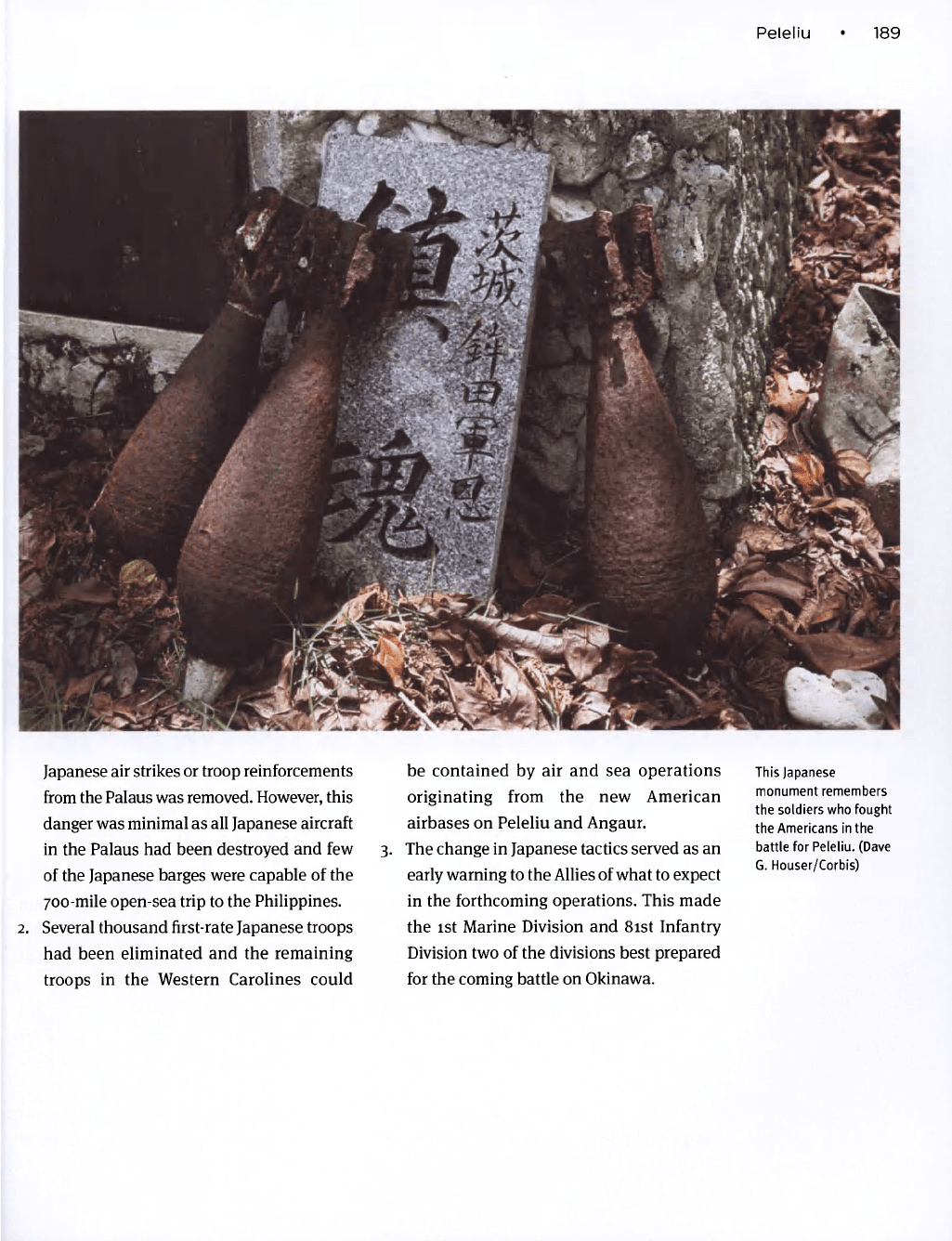
Peleliu • 189
Japanese air strikes or troop reinforcements
from the Palaus was removed. However, this
danger was minimal as all Japanese aircraft
in the Palaus had been destroyed and few
of the Japanese barges were capable of the
700-mile open-sea trip to the Philippines.
2. Several thousand first-rate Japanese troops
had been eliminated and the remaining
troops in the Western Carolines could
be contained by air and sea operations
originating from the new American
airbases on Peleliu and Angaur.
3. The change in Japanese tactics served as an
early warning to the Allies of what to expect
in the forthcoming operations. This made
the 1st Marine Division and 81st Infantry
Division two of the divisions best prepared
for the coming battle on Okinawa.
This Japanese
monument remembers
the soldiers who fought
the Americans in the
battle for Peleliu. (Dave
G. Houser/Corbis)
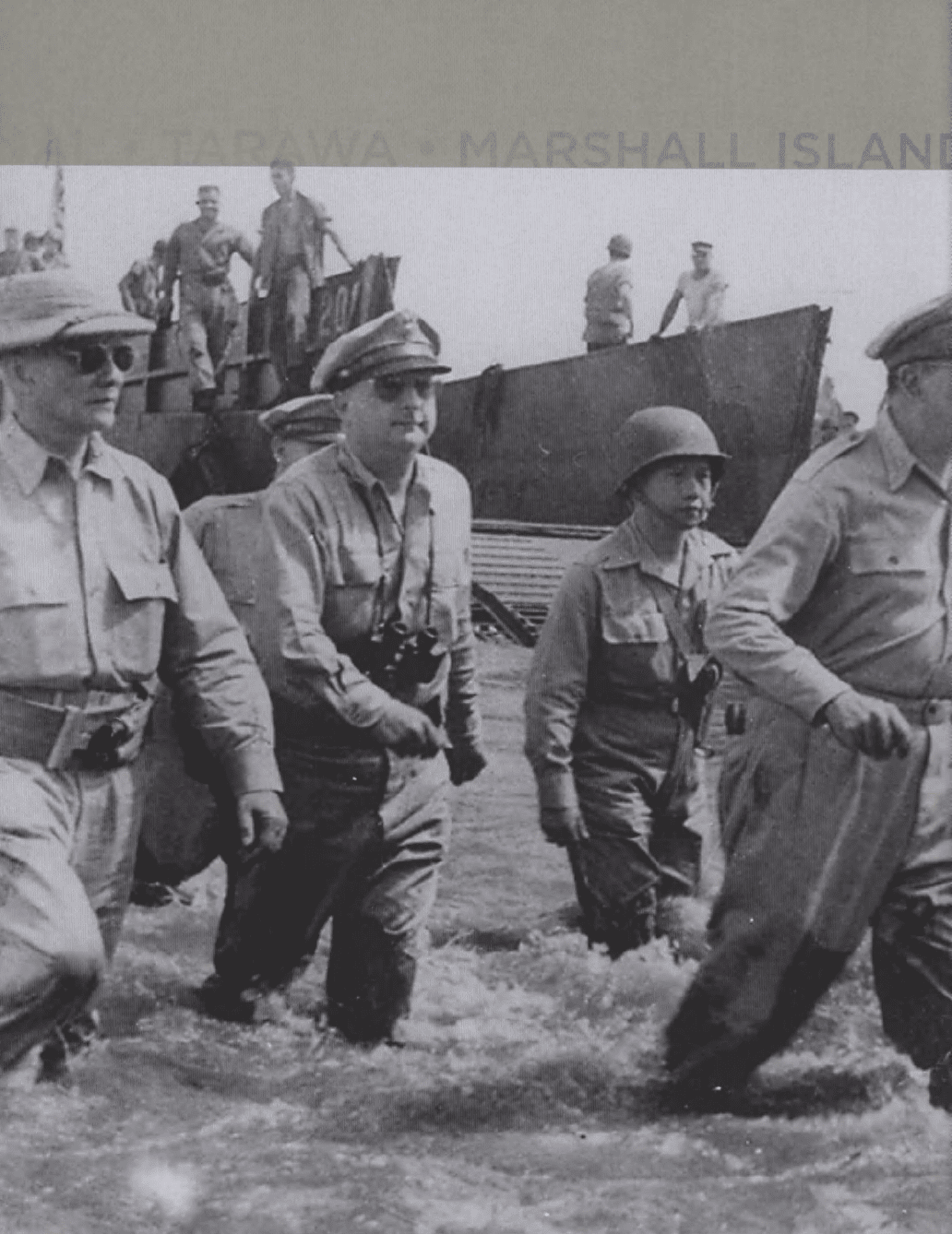
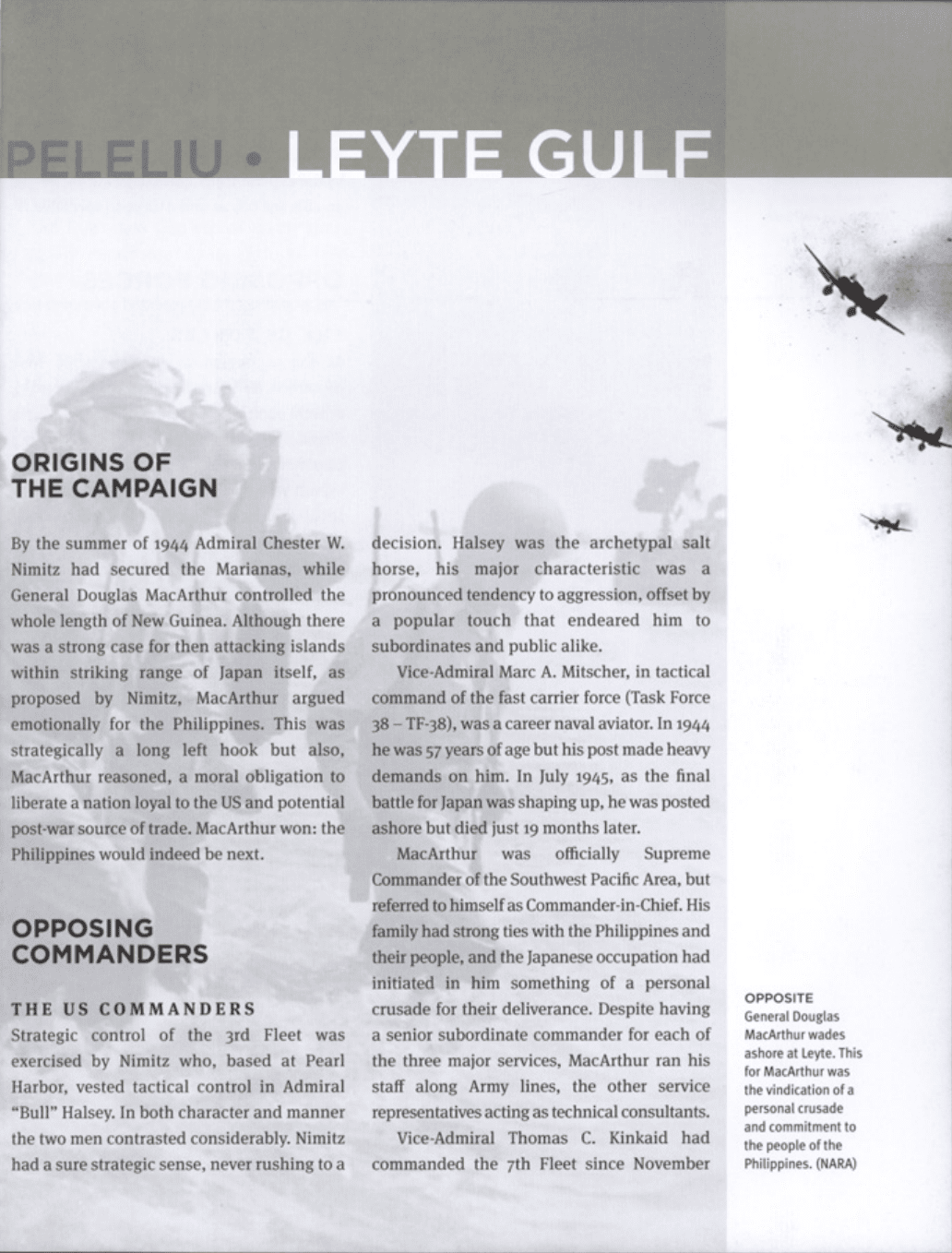
PELELIU
n
V
ORIGINS OF
THE CAMPAIGN
By the summer of 1944 Admiral Chester W.
Nimitz had secured the Marianas, while
General Douglas MacArthur controlled the
whole length of New Guinea. Although there
was a strong case for then attacking islands
within striking range of Japan itself, as
proposed by Nimitz, MacArthur argued
emotionally for the Philippines. This was
strategically a long left hook but also,
MacArthur reasoned, a moral obligation to
liberate a nation loyal to the US and potential
post-war source of trade. MacArthur won: the
Philippines would indeed be next.
OPPOSING
COMMANDERS
THE US COMMANDERS
Strategic control of the 3rd Fleet was
exercised by Nimitz who, based at Pearl
Harbor, vested tactical control in Admiral
"Bull" Halsey. In both character and manner
the two men contrasted considerably. Nimitz
had a sure strategic sense, never rushing to a
decision. Halsey was the archetypal salt
horse, his major characteristic was a
pronounced tendency to aggression, offset by
a popular touch that endeared him to
subordinates and public alike.
Vice-Admiral Marc A. Mitscher, in tactical
command of the fast carrier force (Task Force
38 - TF-38), was a career naval aviator. In 1944
he was 57 years of age but his post made heavy
demands on him. In July 1945, as the final
battle for Japan was shaping up, he was posted
ashore but died just 19 months later.
MacArthur was officially Supreme
Commander of the Southwest Pacific Area, but
referred to himself as Commander-in-Chief. His
family had strong ties with the Philippines and
their people, and the Japanese occupation had
initiated in him something of a personal
crusade for their deliverance. Despite having
a senior subordinate commander for each of
the three major services, MacArthur ran his
staff along Army lines, the other service
representatives acting as technical consultants.
Vice-Admiral Thomas C. Kinkaid had
commanded the 7th Fleet since November
OPPOSITE
General Douglas
MacArthur wades
ashore at Leyte. This
for MacArthur was
the vindication of a
personal crusade
and commitment to
the people of the
Philippines. (NARA)
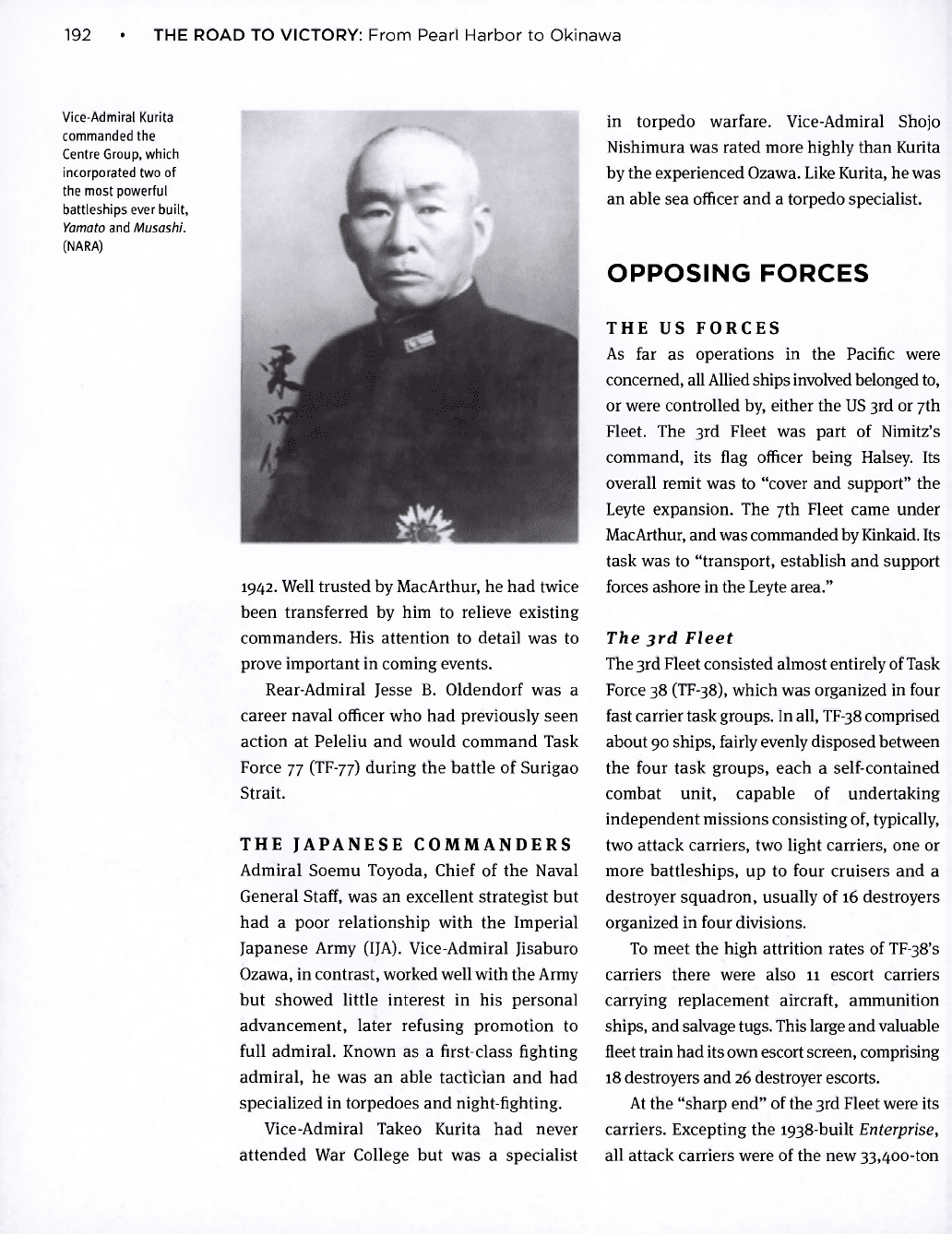
192 • THE ROAD TO VICTORY: From Pearl Harbor to Okinawa
Vice-Admiral Kurita
commanded the
Centre Group, which
incorporated two of
the most powerful
battleships ever built,
Yamato and Musashi.
(NARA)
1942. Well trusted by MacArthur, he had twice
been transferred by him to relieve existing
commanders. His attention to detail was to
prove important in coming events.
Rear-Admiral Jesse B. Oldendorf was a
career naval officer who had previously seen
action at Peleliu and would command Task
Force 77 (TF-77) during the battle of Surigao
Strait.
THE JAPANESE COMMANDERS
Admiral Soemu Toyoda, Chief of the Naval
General Staff, was an excellent strategist but
had a poor relationship with the Imperial
Japanese Army (IJA). Vice-Admiral Jisaburo
Ozawa, in contrast, worked well with the Army
but showed little interest in his personal
advancement, later refusing promotion to
full admiral. Known as a first-class fighting
admiral, he was an able tactician and had
specialized in torpedoes and night-fighting.
Vice-Admiral Takeo Kurita had never
attended War College but was a specialist
in torpedo warfare. Vice-Admiral Shojo
Nishimura was rated more highly than Kurita
by the experienced Ozawa. Like Kurita, he was
an able sea officer and a torpedo specialist.
OPPOSING FORCES
THE US FORCES
As far as operations in the Pacific were
concerned, all Allied ships involved belonged to,
or were controlled by, either the US 3rd or 7th
Fleet. The 3rd Fleet was part of Nimitz's
command, its flag officer being Halsey. Its
overall remit was to "cover and support" the
Leyte expansion. The 7th Fleet came under
MacArthur, and was commanded by Kinkaid. Its
task was to "transport, establish and support
forces ashore in the Leyte area."
The 3rd Fleet
The 3rd Fleet consisted almost entirely of Task
Force 38 (TF-38), which was organized in four
fast carrier task groups. In all, TF-38 comprised
about 90 ships, fairly evenly disposed between
the four task groups, each a self-contained
combat unit, capable of undertaking
independent missions consisting of, typically,
two attack carriers, two light carriers, one or
more battleships, up to four cruisers and a
destroyer squadron, usually of 16 destroyers
organized in four divisions.
To meet the high attrition rates of TF-38's
carriers there were also 11 escort carriers
carrying replacement aircraft, ammunition
ships, and salvage tugs. This large and valuable
fleet train had its own escort screen, comprising
18 destroyers and 26 destroyer escorts.
At the "sharp end" of the 3rd Fleet were its
carriers. Excepting the 1938-built Enterprise,
all attack carriers were of the new 33,400-ton
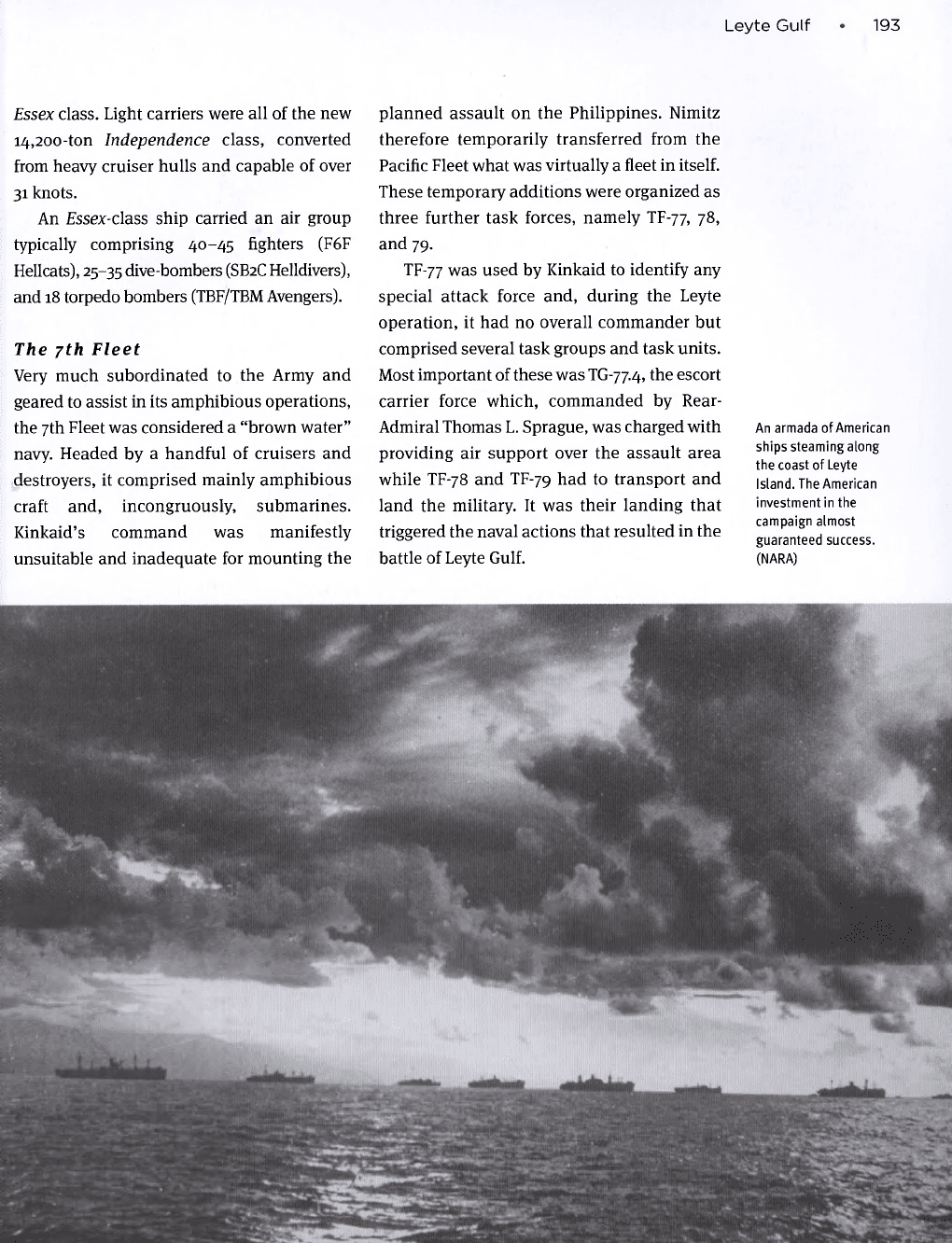
Leyte Gulf •
193
Essex class. Light carriers were all of the new
14,200-ton Independence class, converted
from heavy cruiser hulls and capable of over
31 knots.
An Essex-class ship carried an air group
typically comprising 40-45 fighters (F6F
Hellcats), 25-35 dive-bombers (SB2C Helldivers),
and 18 torpedo bombers (TBF/TBM Avengers).
The 7th Fleet
Very much subordinated to the Army and
geared to assist in its amphibious operations,
the 7th Fleet was considered a "brown water"
navy. Headed by a handful of cruisers and
destroyers, it comprised mainly amphibious
craft and, incongruously, submarines.
Kinkaid's command was manifestly
unsuitable and inadequate for mounting the
planned assault on the Philippines. Nimitz
therefore temporarily transferred from the
Pacific Fleet what was virtually a fleet in itself.
These temporary additions were organized as
three further task forces, namely TF-77, 78,
and 79.
TF-77 was used by Kinkaid to identify any
special attack force and, during the Leyte
operation, it had no overall commander but
comprised several task groups and task units.
Most important of these was TG-77.4, the escort
carrier force which, commanded by Rear-
Admiral Thomas L. Sprague, was charged with
providing air support over the assault area
while TF-78 and TF-79 had to transport and
land the military. It was their landing that
triggered the naval actions that resulted in the
battle of Leyte Gulf.
An armada of American
ships steaming along
the coast of Leyte
Island. The American
investment in the
campaign almost
guaranteed success.
(NARA)
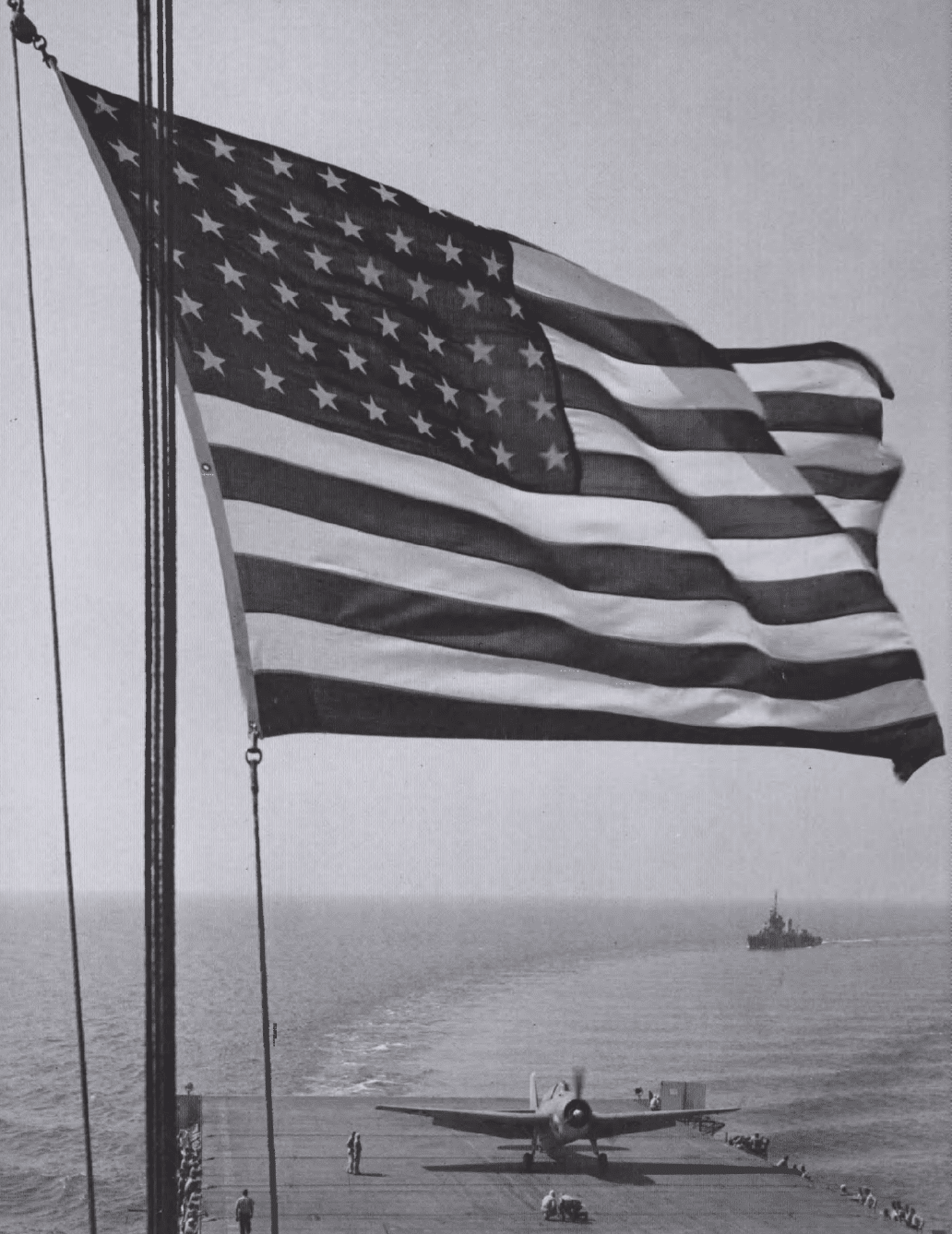
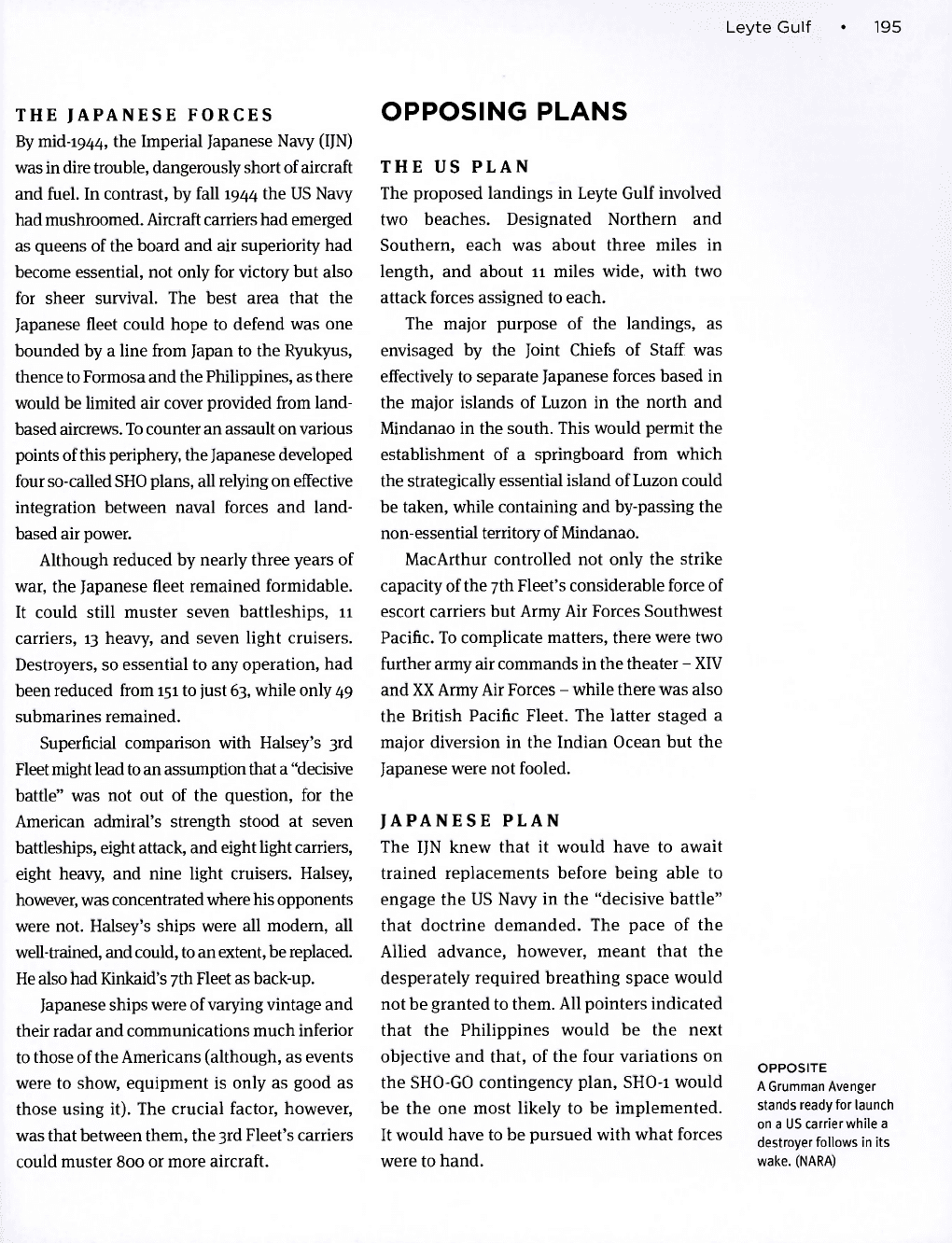
Leyte Gulf • 195
THE JAPANESE FORCES
By mid-1944, the Imperial Japanese Navy (IJN)
was in dire trouble, dangerously short of
aircraft
and fuel. In contrast, by fall 1944 the US Navy
had mushroomed. Aircraft carriers had emerged
as queens of the board and air superiority had
become essential, not only for victory but also
for sheer survival. The best area that the
Japanese fleet could hope to defend was one
bounded by a line from Japan to the Ryukyus,
thence to Formosa and the Philippines, as there
would be limited air cover provided from land-
based aircrews. To counter an assault on various
points of
this
periphery, the Japanese developed
four so-called SHO plans, all relying on
effective
integration between naval forces and land-
based air power.
Although reduced by nearly three years of
war, the Japanese fleet remained formidable.
It could still muster seven battleships, 11
carriers, 13 heavy, and seven light cruisers.
Destroyers, so essential to any operation, had
been reduced from 151 to just 63, while only 49
submarines remained.
Superficial comparison with Halsey's 3rd
Fleet might lead
to
an assumption that a "decisive
battle" was not out of the question, for the
American admiral's strength stood at seven
battleships, eight attack, and eight light carriers,
eight heavy, and nine light cruisers. Halsey,
however, was concentrated where his opponents
were not. Halsey's ships were all modern, all
well-trained, and could, to an extent, be replaced.
He also had Kinkaid's 7th Fleet as back-up.
Japanese ships were of varying vintage and
their radar and communications much inferior
to those of the Americans (although, as events
were to show, equipment is only as good as
those using it). The crucial factor, however,
was that between them, the 3rd Fleet's carriers
could muster 800 or more aircraft.
OPPOSING PLANS
THE US PLAN
The proposed landings in Leyte Gulf involved
two beaches. Designated Northern and
Southern, each was about three miles in
length, and about 11 miles wide, with two
attack forces assigned to each.
The major purpose of the landings, as
envisaged by the Joint Chiefs of Staff was
effectively to separate Japanese forces based in
the major islands of Luzon in the north and
Mindanao in the south. This would permit the
establishment of a springboard from which
the strategically essential island of Luzon could
be taken, while containing and by-passing the
non-essential territory of Mindanao.
MacArthur controlled not only the strike
capacity of the 7th Fleet's considerable force of
escort carriers but Army Air Forces Southwest
Pacific. To complicate matters, there were two
further army air commands in the theater - XIV
and XX Army Air Forces - while there was also
the British Pacific Fleet. The latter staged a
major diversion in the Indian Ocean but the
Japanese were not fooled.
JAPANESE PLAN
The IJN knew that it would have to await
trained replacements before being able to
engage the US Navy in the "decisive battle"
that doctrine demanded. The pace of the
Allied advance, however, meant that the
desperately required breathing space would
not be granted to them. All pointers indicated
that the Philippines would be the next
objective and that, of the four variations on
the SHO-GO contingency plan, SHO-i would
be the one most likely to be implemented.
It would have to be pursued with what forces
were to hand.
OPPOSITE
A Grumman Avenger
stands ready for launch
on a US carrier while a
destroyer follows in its
wake. (NARA)
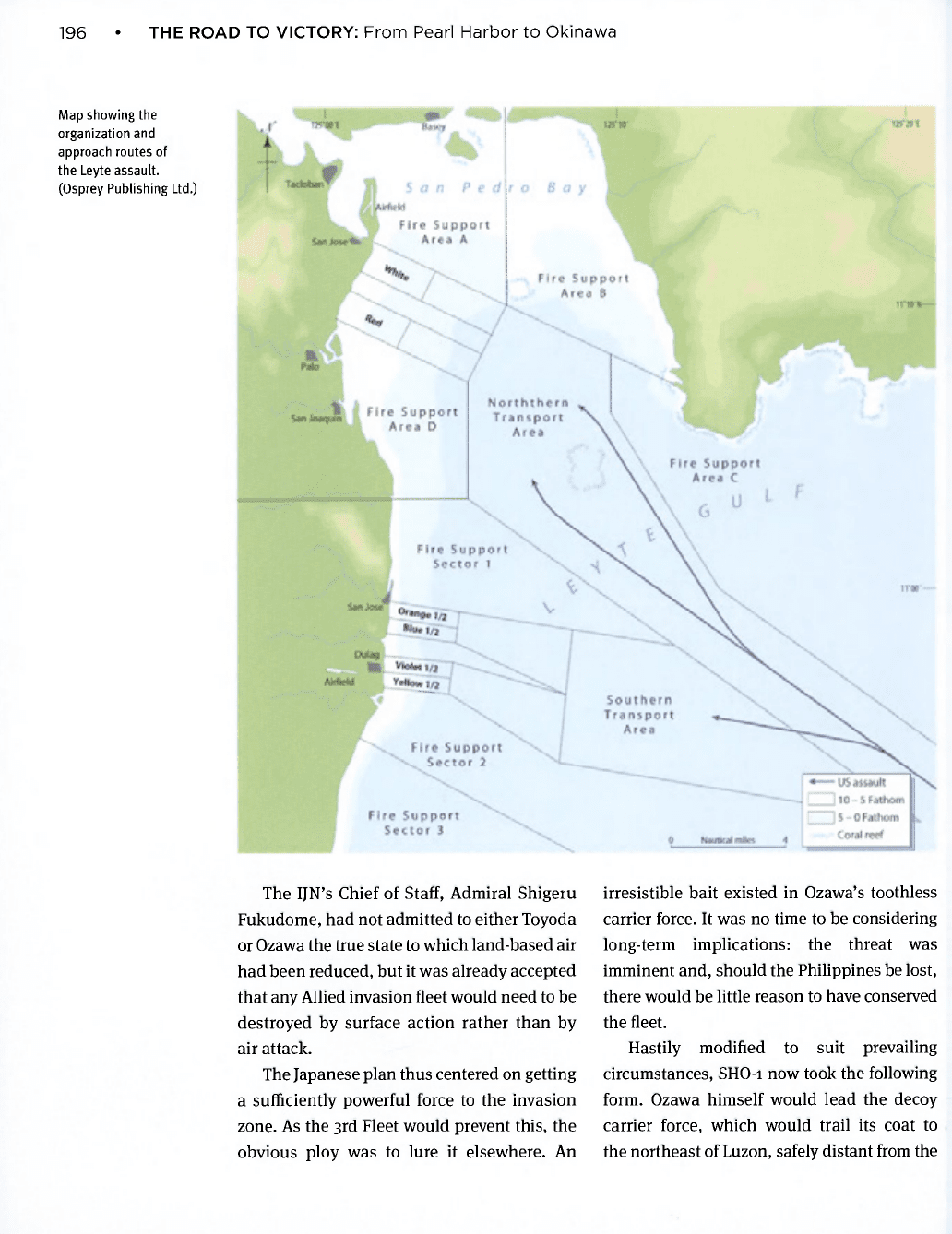
196 • THE ROAD TO VICTORY: From Pearl Harbor to Okinawa
Map showing the
organization and
approach routes of
the Leyte assault.
(Osprey Publishing Ltd.)
The IJN's Chief of Staff, Admiral Shigeru
Fukudome, had not admitted to either Toyoda
or Ozawa the true state to which land-based air
had been reduced, but it was already accepted
that any Allied invasion fleet would need to be
destroyed by surface action rather than by
air attack.
The Japanese plan thus centered on getting
a sufficiently powerful force to the invasion
zone. As the 3rd Fleet would prevent this, the
obvious ploy was to lure it elsewhere. An
irresistible bait existed in Ozawa's toothless
carrier force. It was no time to be considering
long-term implications: the threat was
imminent and, should the Philippines be lost,
there would be little reason to have conserved
the fleet.
Hastily modified to suit prevailing
circumstances, SHO-i now took the following
form. Ozawa himself would lead the decoy
carrier force, which would trail its coat to
the northeast of Luzon, safely distant from the
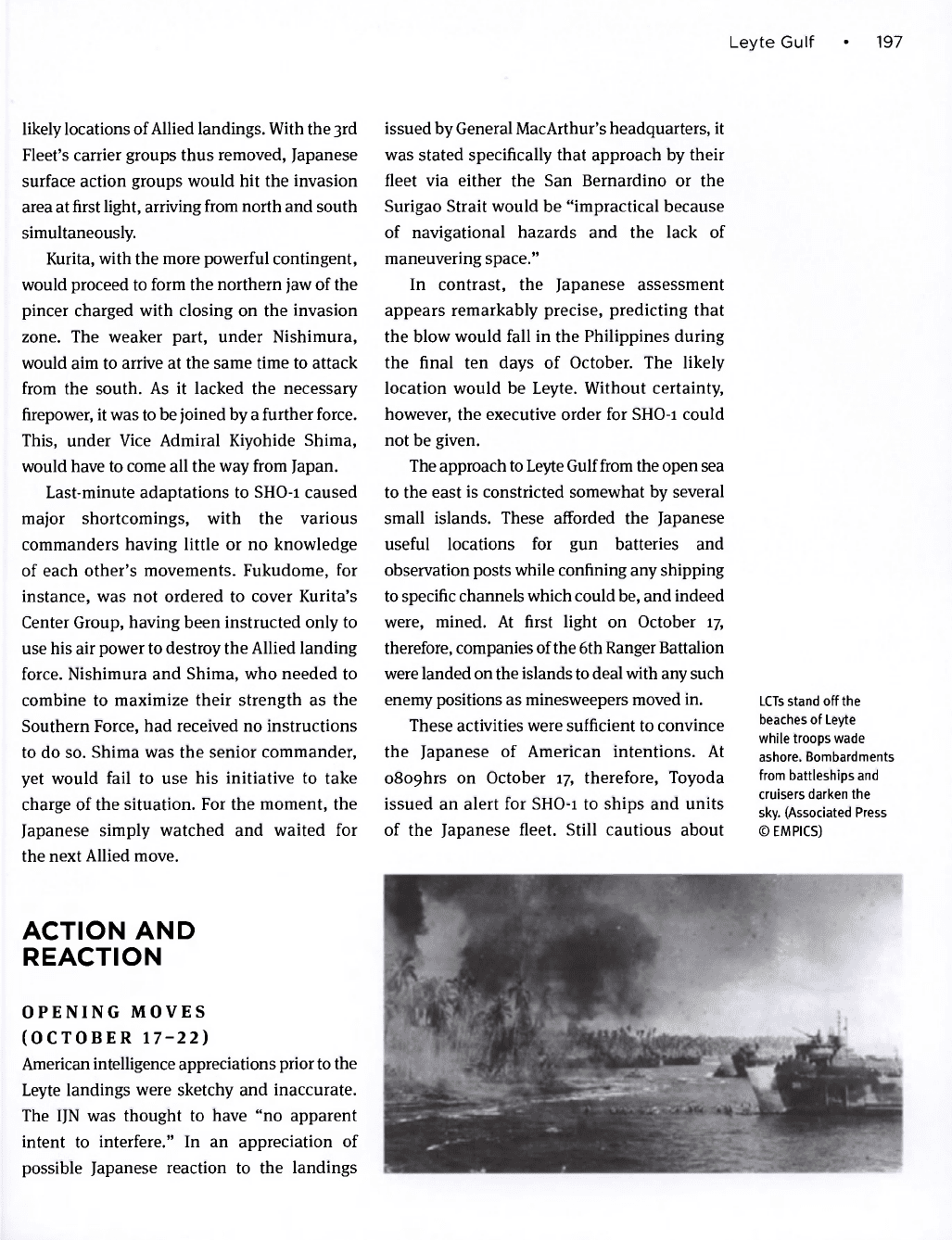
Leyte Gulf • 197
likely locations of Allied landings. With the 3rd
Fleet's carrier groups thus removed, Japanese
surface action groups would hit the invasion
area at first light, arriving from north and south
simultaneously.
Kurita, with the more powerful contingent,
would proceed to form the northern jaw of the
pincer charged with closing on the invasion
zone. The weaker part, under Nishimura,
would aim to arrive at the same time to attack
from the south. As it lacked the necessary
firepower, it was to be joined by a further force.
This, under Vice Admiral Kiyohide Shima,
would have to come all the way from Japan.
Last-minute adaptations to SHO-i caused
major shortcomings, with the various
commanders having little or no knowledge
of each other's movements. Fukudome, for
instance, was not ordered to cover Kurita's
Center Group, having been instructed only to
use his air power to destroy the Allied landing
force. Nishimura and Shima, who needed to
combine to maximize their strength as the
Southern Force, had received no instructions
to do so. Shima was the senior commander,
yet would fail to use his initiative to take
charge of the situation. For the moment, the
Japanese simply watched and waited for
the next Allied move.
ACTION AND
REACTION
OPENING MOVES
(OCTOBER 17-22)
American intelligence appreciations prior to the
Leyte landings were sketchy and inaccurate.
The IJN was thought to have "no apparent
intent to interfere." In an appreciation of
possible Japanese reaction to the landings
issued by General MacArthur's headquarters, it
was stated specifically that approach by their
fleet via either the San Bernardino or the
Surigao Strait would be "impractical because
of navigational hazards and the lack of
maneuvering space."
In contrast, the Japanese assessment
appears remarkably precise, predicting that
the blow would fall in the Philippines during
the final ten days of October. The likely
location would be Leyte. Without certainty,
however, the executive order for SHO-i could
not be given.
The approach to Leyte Gulf from the open sea
to the east is constricted somewhat by several
small islands. These afforded the Japanese
useful locations for gun batteries and
observation posts while confining any shipping
to specific channels which could be, and indeed
were, mined. At first light on October 17,
therefore, companies of the 6th Ranger Battalion
were landed on the islands to deal with any such
enemy positions as minesweepers moved in.
These activities were sufficient to convince
the Japanese of American intentions. At
o8o9hrs on October 17, therefore, Toyoda
issued an alert for SHO-i to ships and units
of the Japanese fleet. Still cautious about
LCTs stand off the
beaches of Leyte
while troops wade
ashore. Bombardments
from battleships and
cruisers darken the
sky. (Associated Press
©EM PICS)
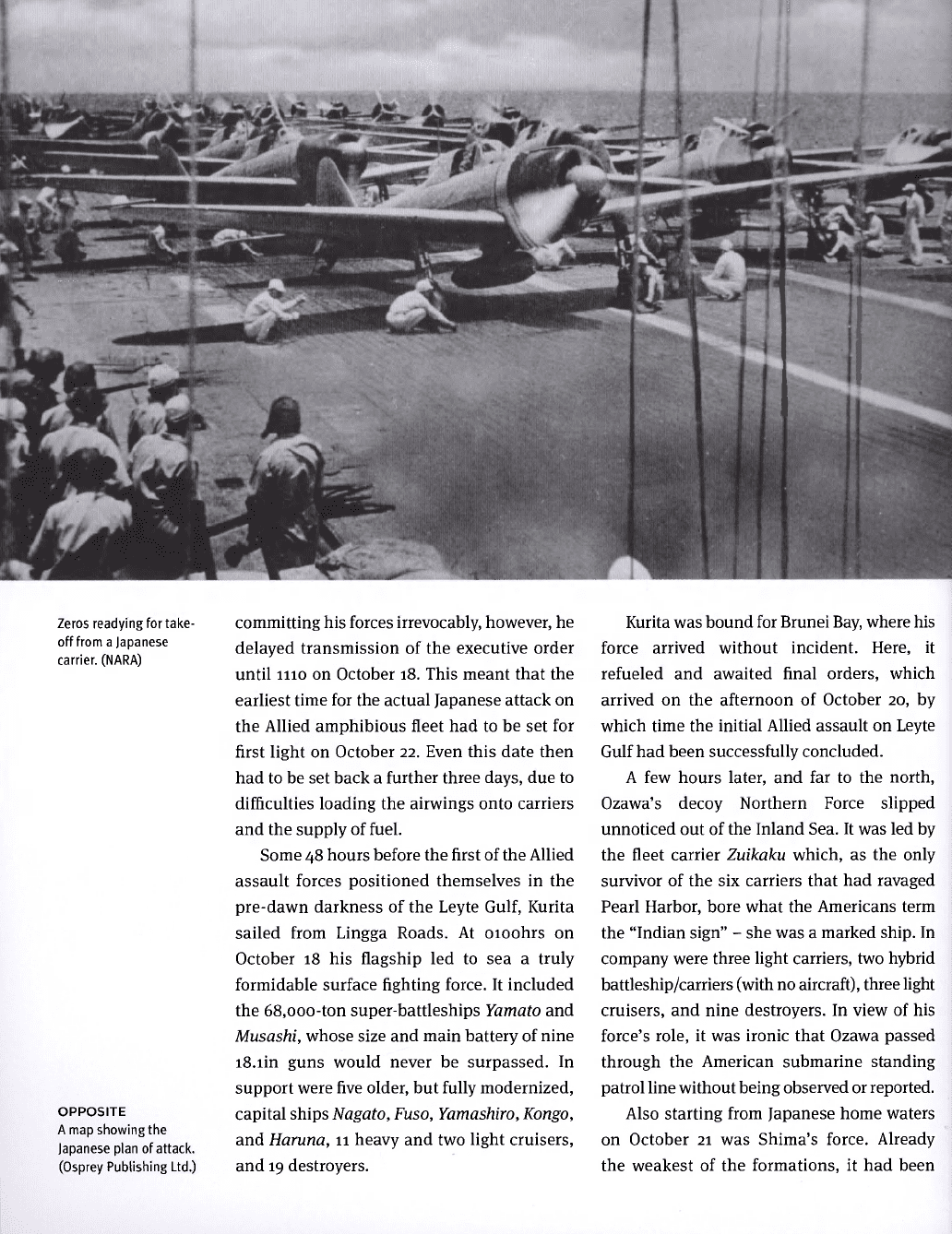
Zeros readying for take-
off from a Japanese
carrier. (NARA)
OPPOSITE
A map showing the
Japanese plan of attack.
(Osprey Publishing Ltd.)
committing his forces irrevocably, however, he
delayed transmission of the executive order
until 1110 on October 18. This meant that the
earliest time for the actual Japanese attack on
the Allied amphibious fleet had to be set for
first light on October 22. Even this date then
had to be set back a further three days, due to
difficulties loading the airwings onto carriers
and the supply of fuel.
Some 48 hours before the first of the Allied
assault forces positioned themselves in the
pre dawn darkness of the Leyte Gulf, Kurita
sailed from Lingga Roads. At oioohrs on
October 18 his flagship led to sea a truly
formidable surface fighting force. It included
the 68,ooo-ton super-battleships Yamato and
Musashi, whose size and main battery of nine
i8.iin guns would never be surpassed. In
support were five older, but fully modernized,
capital ships Nagato, Fuso, Yamashiro, Kongo,
and Haruna, 11 heavy and two light cruisers,
and 19 destroyers.
Kurita was bound for Brunei Bay, where his
force arrived without incident. Here, it
refueled and awaited final orders, which
arrived on the afternoon of October 20, by
which time the initial Allied assault on Leyte
Gulf had been successfully concluded.
A few hours later, and far to the north,
Ozawa's decoy Northern Force slipped
unnoticed out of the Inland Sea. It was led by
the fleet carrier Zuikaku which, as the only
survivor of the six carriers that had ravaged
Pearl Harbor, bore what the Americans term
the "Indian sign" - she was a marked ship. In
company were three light carriers, two hybrid
battleship/carriers (with no aircraft), three light
cruisers, and nine destroyers. In view of his
force's role, it was ironic that Ozawa passed
through the American submarine standing
patrol line without being observed or reported.
Also starting from Japanese home waters
on October 21 was Shima's force. Already
the weakest of the formations, it had been
